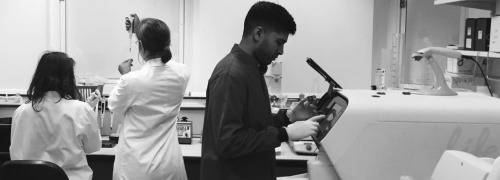We are developing a completely non-invasive approach to detecting cancer risk. The methodology can be used for any cancer, but in the first phase, we are concentrating on oesophageal cancer.

Salivary Diagnostics using Multiomics Technologies
A New Way to Detect Cancer Risk
We are proud to be at the forefront of this new area of research. We are developing a completely non-invasive approach to detecting cancer risk. Our methodology can be used for any cancer, but in the first phase, we are concentrating on oesophageal cancer detection.
The problem with the two-week-wait cancer pathway
Persistent heartburn is common, with the average GP seeing one or two cases every day. It is also usually benign. 15 years ago, the UK government began an expedited cancer referral ('two-week wait') pathway to improve speed of referral for patients with suspected cancer for hospital investigation. Persistent heartburn is a major trigger for referral as it is an occasional symptom of oesophageal cancer, although it is not at all specific for this disease.
Despite the poor utility of the symptom, the government's 2015 'Be Clear on Cancer' campaign highlighted it and encouraged sufferers to seek help from their doctors. This was because there are few specific pointers towards early cancer but early diagnosis is known to save lives. The GP is therefore forced into recommending endoscopy for people with persistent heartburn.
The proven outcome is a cost to the NHS of around £70 million per year but no increase in cancer detection rate. Furthermore, the discomfort and anxiety caused to patients is immense.
This psychological morbidity is sacrificed to the altar of better diagnosis, which does not actually follow, and may be better described as political expedience. We need a new way forward to reduce wasted resources spent on normal endoscopy whilst ensuring that patients who do have cancer are not missed.
Improved targeting of high-risk patients
Better targeting of symptoms and risk factors should distinguish patients with significant pathology to some degree. But there is now a new approach as well. Changes in gene expression are reflected in altered cellular messenger RNA (mRNA) levels. These molecules convert DNA code into proteins. These expression changes have proven associations with all cancers where they have been sought.
Very recently, it has become apparent that cells shed exosomes, small cell derived vesicles, into the blood and from there into saliva. These vesicles contain tiny fragments of mRNA. It is very difficult to detect the exceptionally low (nanogram) levels of mRNA in saliva, but our laboratory has the state-of-the-art equipment and the expertise to do this.
We asked whether targeted analysis of key salivary mRNA markers combined with a series of demographic and symptom data may be used to create a low-cost screening test which would lead to a significant reduction in the need for endoscopy in patients who do not have cancer.
Collaborative work led by UCL
Due to the data complexity, normal bioinformatics are not adequate for analysis. We developed a collaboration with Professor Rosenfeld, an artificial intelligence expert in Israel to analyse the 'big-data' we are generating with novel computer science approaches.
We have now created a preliminary algorithm based on extensive work on symptoms, risk factors and transcriptomic analysis in 80 patients. This shows an almost perfect sensitivity together with a 75% specificity for differentiating between low-risk and high-risk patients. The finding translates into a projected reduction in endoscopy tests of 75%. Once implemented, the cost of the test is calculated to be as low as £1.
The findings from other screening programmes is that uptake is unlikely to be more than 50% in the first few years, so the initial cost savings of our tool are calculated to be £28 million per year to the NHS. Internationally, the savings will be many times greater and the utility is likely to be worldwide.
The project plan
We are now refining our tool further using both epigenetics and transcriptomics and will then validate it independently. We are already collecting further samples in our own hospital, UCLH, and partner hospitals are collecting samples for us as well.
Over the next few years, we will optimise our data collection protocols, refine our tool and do more in-depth analysis of existing and new samples, with an independent validation cohort. It will also confirm the robustness of our approach which will open the way to much larger national trials.
There will also be significant scope to commercialise this new product as we have recently filed a patent with support from UCL Business, the commercial arm of UCL.
Contact: Professor Laurence Lovat: l.lovat@ucl.ac.uk.
 Close
Close

